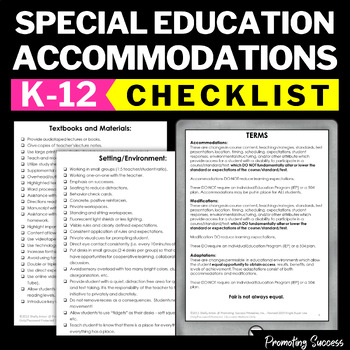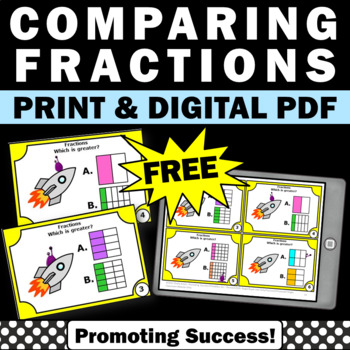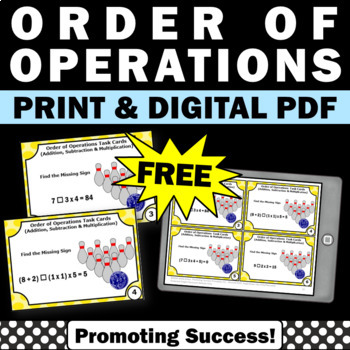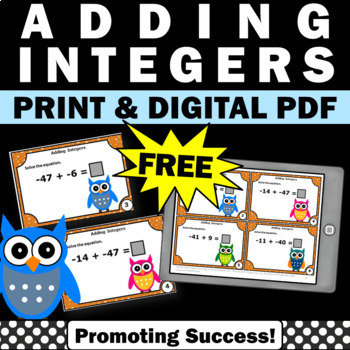Meeting the Needs of All Students: Strategies and Accommodations
Creating an inclusive classroom means more than just following IEPs and 504 Plans—it means meeting students where they are and supporting their unique paths to success. Whether you're working with students who have ADHD, special education needs, or language barriers, the right accommodations can make all the difference.
👉 Click here to grab your free checklist.
Use it during IEP meetings, planning sessions, or classroom support discussions—it’s practical, flexible, and ready to use!
Used by thousands of teachers from preschool through adult ed, it’s a must-have for your resource library.
Here’s how they align with top accommodations:
With thoughtful accommodations, consistent strategies, and a toolbox of flexible resources, you can create a learning environment where every student feels seen, supported, and successful.
Don’t forget to grab your free Top 20 Accommodations Checklist to simplify your planning:
👉 Click here to download now.
You’ve got this—and I’m here to help every step of the way.
Before we begin…
If you’re looking for a simple reference tool, I created a free printable checklist of the Top 20 Classroom Accommodations to support students with IEPs, 504 Plans, ADHD, or academic challenges.👉 Click here to grab your free checklist.
Use it during IEP meetings, planning sessions, or classroom support discussions—it’s practical, flexible, and ready to use!
Why Differentiation Is Non-Negotiable
Every student learns differently. Differentiation helps ensure all learners—especially those with ADHD, learning disabilities, or language differences—are engaged and able to access grade-level content. It’s not about lowering expectations; it’s about removing barriers.When we differentiate, we allow students to thrive in ways that reflect their strengths.
Quick Look: What Is ADHD?
ADHD affects nearly 6 million U.S. children, with symptoms like inattention, impulsivity, and hyperactivity. Students with ADHD may struggle with traditional classroom routines but flourish with the right supports.Common challenges include:
- Staying on task
- Managing transitions
- Organizing assignments
- Processing instructions
A Smart Approach to Accommodations
Effective accommodations aren’t one-size-fits-all. Here’s a simple, proven process to make them work:- Start Small: Choose just 1–2 accommodations at a time.
- Explicitly Teach It: Model how to use the accommodation and practice it with the student.
- Set Clear Goals: What behavior or skill are you aiming to improve?
- Track Data: Observe over time—sometimes behavior dips before it improves.
- Evaluate & Adjust: Use what you learn to refine your support.
- Collaborate as a Team: Input from parents, specialists, and general ed teachers is key
20 Accommodations That Help All Students Succeed
These strategies are especially helpful for students with ADHD, IEPs, or 504 Plans—but they benefit every learner in your room.- Written Schedules & Assignments: Post daily plans so students know what’s coming.
- Advance Notice of Changes: Reduces anxiety from surprise transitions.
- Consistent Routines: Builds security and structure.
- Movement Breaks: Short physical breaks boost focus and reduce restlessness.
- Visual Instructions: Reinforce verbal directions with images or examples.
- Chunking Assignments: Break tasks into smaller parts with check-ins or breaks.
- Private Cues: Use discreet signals to redirect attention without embarrassment.
- Hands-On Learning: Engage students through movement, touch, and exploration.
- Flexible Seating: Offer options like standing desks or wiggle cushions.
- Transition Signals: Use timers, lights, or sounds to prep for changes.
- Color Coding: Highlight key info for easier focus and recall.
- Quiet Zones: Minimize background distractions during independent work.
- Alternative Responses: Use whiteboards, drawing, or partner talks instead of cold calls.
- Lecture Outlines: Help students follow along with key ideas already outlined.
- Fidgets (when appropriate): Small tools can help regulate focus.
- Pre-Transition Warnings: Give 1–2 minutes notice before changing tasks.
- Audio Support: Read aloud directions or let students use audiobooks.
- Headphones: White noise or soft music can help with focus.
- ESL Supports: Use visuals, sentence starters, or translated directions.
- Modified Assignments: Reduce quantity—not rigor—based on student needs.
Want all 175+ accommodations in one place?
👉 Click here to get the full checklist for IEP & 504 planning.Used by thousands of teachers from preschool through adult ed, it’s a must-have for your resource library.
Let’s Talk Task Cards: A Powerful, Flexible Tool
Looking for a hands-on way to implement accommodations with ease? Task cards offer built-in flexibility, movement, and engagement—perfect for supporting attention, differentiation, and transitions.Here’s how they align with top accommodations:
- Movement-Friendly: Use Scoot, floor games, or card scavenger hunts to keep students active.
- Customizable for Chunking: Assign only a portion of cards based on student ability.
- Visual + Hands-On: Combine task cards with math manipulatives or visuals.
- Built-In Transitions: Moving from card to card creates structure and flow.
- Color & Engagement: Bright designs draw attention and boost motivation.
Task cards are a versatile tool that can support a wide range of accommodations, making them a great addition to any teacher’s toolkit. Give them a try, and see how they can enhance your classroom!
Final Thoughts
Meeting the needs of all students is not about doing more—it’s about doing what matters most.With thoughtful accommodations, consistent strategies, and a toolbox of flexible resources, you can create a learning environment where every student feels seen, supported, and successful.
Don’t forget to grab your free Top 20 Accommodations Checklist to simplify your planning:
👉 Click here to download now.
You’ve got this—and I’m here to help every step of the way.
Check out these free TPT resources from my store:
Click HERE to view my Promoting Success store on TPT.
Shelly Anton is a participant in the Amazon Services LLC Associates Program, an affiliate advertising program designed to provide a means for sites to earn advertising fees by advertising and linking to Amazon.com. ** This means there are Amazon affiliate links in these blog posts. This does not mean you pay a dime more when you purchase a product through the link. It just means I am trying to save you valuable teacher time by making it easier for you to find teaching resources for your students, and I earn a few cents for my research and time. Thank you for all you do for kids!

.png)













I help reluctant or written output difficulties by wheeling my chair up to them with my laptop on my lap and I type out their stories for them. After I print it they are often able to add more on their own and they are so proud. I also use brain based learning that is so successful and easy to implement : http://www.teacherspayteachers.com/Product/Mindful-Brains-Mindful-Hearts
ReplyDeleteI have used a similar approach with my students. Actually when I was writing a lot of papers for my endorsement, I used the same strategy for myself. I am definitely a visual learner! Thank you for sharing!
ReplyDeleteI make good use of lap weights and weighted vests. I also periodically schedule movement and heavy work breaks.
ReplyDeleteThis comment has been removed by a blog administrator.
DeleteMy daughter has ADHD (she is now 23). What strategy worked best for her was to chunk the assignments into smaller sections. Kids with ADHD get overwhelmed very easily.
ReplyDeleteThis comment has been removed by a blog administrator.
ReplyDeleteThis comment has been removed by a blog administrator.
ReplyDeleteThis comment has been removed by a blog administrator.
ReplyDeleteI've had some great success with doodle books. Kids have a little notebook where they make a two column page. On one side they doodle as they listen and on the other sketch key ideas or key words from the lesson. The therapy band stretched across chair legs is a favorite coping strategy for my kiddos who need to move. Love working with these sweeties. Don't forget the number one strategy they need is how to respectfully communicate and advocate for their own learning needs!
ReplyDeleteI would love some advice on the best practices on figuring out if your child has ADHD.
ReplyDeleteI think the best way to find out is to see a therapist and have a psychologist make a determination and prognosis.
DeleteManoj Lekhi | The Success Cue is a Management Program | It is about Vision, Beliefs, Organising & Planning | Time Management and Money | Science of Silence
ReplyDeleteSuccess Cue Management Program
I have bookmarked your blog, the articles are way better than other similar blogs.. thanks for a great blog!
ReplyDeletestudentenkamers leuven
Wonderful illustrated information. I thank you about that. No doubt it will be very useful for my future projects. Would like to see some other posts on the same subject! Klicka vidare till sajten
ReplyDeleteThis is the type of information I’ve long been trying to find. Thank you for writing this information. hilangkan jerawat
DeleteOur oldest son has ADHD with hyperactivity, he’s in the Fourth grade. Writing for school has always been tough for him. We're grateful to have discovered INK, he seems to concentrate better since he started using it. I'm really impressed with all of the accessibility features like the offline mode. This seemed like a good place to recommend it: http://bit.ly/2DWi1K9
ReplyDeleteConsequently making one wonder of exactly the amount of the benefits should be assigned to reinvestment, and towards what objectives. aplikasi domino qq
ReplyDeleteI recently came across your blog and have been reading along. I thought I would leave my first comment. I don’t know what to say except that I have enjoyed reading. Your Virtual Office London yourvirtualofficelondon.co.uk
ReplyDelete